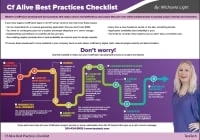David Tattersall talks about “FusionReactor Application Performance Monitor – Why It’s Different Than Other APM Tools and What’s New in Version 7 & the CLOUD” in this episode of ColdFusion Alive Podcast with host Michaela Light. His flagship product – FusionReactor is used on over 25,000 production servers and has been purchased by over 5,000 customers.
Show notes
- What exactly is FusionReactor?
- Low overhead CF and Java application performance monitor
- It can measure 100’s of different metrics + alert you to potential issues
- How long has FusionReactor been around and who’s using it?
- First launched in 2005
- 5,000+ customers, 80% US
- 25,000+ servers running FR in production
- What differentiates FusionReactor from other Java APM tools?
- Crash protection and improved application/server resilience
- Built in low overhead, safe & secure, familiar “developer tools” – debugger, line profiler and memory analyzer – help you get to the root of the problem as fast as possible in your production environment
- What’s the overhead on the server when running FusionReactor?
- Less than 1% overhead compared to 2-5% on other monitors
- What is exciting in the new version 7?
- Support for JMX (Java Managment Extensions)
- MBeans (Managed Beans)
- → Better metrics
- Direct integration between FusionReactor and AWS Cloud watch
- Debugger one click breakpoint, decompile your code on the fly
- Memory Analyzer – identify heap utilization – spot memory leaks
- Why did you add FR to the CLOUD?
- Save server monitoring data to the cloud so it doesn’t clog up your server
- Combining metrics from multiple servers (instances), say across a cluster, to provide a combined application view
- Powerful alerting engine on any of the metrics in FusionReactor CLOUD, with integration to many common Alerting Channels – such as
- FusionAnalytics for on premise, in-depth analysis
- Two way link from FR CLOUD to the local FR so can run a stack trace or GC from the cloud
- Webinar on this at https://www.fusion-reactor.com/webinar/fusionreactor-cloud/
- Use FR to monitor FR CLOUD
- What versions of ACF and Lucee does FR work with?
- ACF 6.1, 7 MX (FusionReactor 4.5)
- ACF 8,9,10, 11, 2016 (latest version of FR)
- Railo 3.x, 4.x
- Lucee 4.5, 5.x
- Also supports Java containers e.g. Tomcat, JBoss, GLassfish, Websphere + many Java frameworks e.g. Spring and Struts
- What is in your dev roadmap for the next year?
- FR 7 launch
- FusionReactor CLOUD launch
- Intelligent analysis of data – to determine why something is broken
- Log analysis
- Introduction of a new agent for Node.js monitoring
- Why do you support CF conferences around the world?
- Why are you proud to support CF?
- WWIT for CF to be more alive this year?
Mentioned in this episode
- CF and JVM server Log files
- JProfiler
- Remote production debugging CF code
- JVisualVM
- MAT
- GC Roots analysis
- Memory leak detection
- Debugging
- Line Profiler
- Memory profiler
- Session management
- JVM metrics and Garbage Collector
- JMX MBeans
- UEM (User Experience Monitoring)
- FusionReactor Standard, Enterprise, Ultimate
- FusionAnalytics
- Velocity DevOps conference
Listen to the Audiio
Bio
David Tattersall
David Tattersall has been in working in IT for over 30 years. Since co-founding Intergral in 1998, he focused on company management, business development and sales & marketing. Intergral has become a leader in server monitoring and application performance monitoring (APM) solutions in the ColdFusion / Java segment. His flagship product – FusionReactor – www.fusion-reactor.com is used on over 25,000 production servers and has been purchased by over 5,000 customers.
Interview Transcript
Michael: Welcome back to the show. I'm here with David Tattersall and he's speaking to us from his home office in Germany, near the world headquarters of Intergral, who made FusionReactor, amazing server monitor. And we're going to be looking at what exactly FusionReactor is and how it's different from all the other tools that you can use to monitor your server. And what's exciting in new version seven that's coming out real soon now, though I can't quite get to a date from David. You know how it is with-
Michael: Yes. We're going to also look at how FusionReactor works in the cloud and what versions of ColdFusion and Lucee does it work with. And we'll also look at the roadmap for FusionReactor coming up. So lots of exciting stuff. So welcome, David.
David : Thank you, Thank you, Michael. Thank you for having me on the show.
Michael: You are so welcome. So what exactly is FusionReactor? I'm sure there's at least three people listening who haven't got a clue what FusionReactor is. You want to enlighten them?
David : Yeah, so FusionReactor is the global market leader for performance monitoring on the ColdFusion platform. FusionReactor is a low-overhead Java monitor. It gives developers DevOps and operations folks a really deep insight into exactly how their applications are performing and how they execute a production runtime. FusionReactor's a hybrid monitor so it's always on premise. And we've also got a cloud version, so FusionReactor CLOUD, so you can extend it into the cloud.
Michael: How long has it been around, David?
David : It's been around since we first launched FusionReactor in 2005. So-
Michael: So 12 years? It's nearly a teenager.
David : Coming onto 12 years, yes. We've got around 5,000 customers that's taken FusionReactor. We've got at least 25-plus thousand servers running FusionReactor in production right now.
Read more
And to continue learning how to make your ColdFusion apps more modern and alive, I encourage you to download our free ColdFusion Alive Best Practices Checklist.
Because… perhaps you are responsible for a mission-critical or revenue-generating CF application that you don’t trust 100%, where implementing new features is a painful ad-hoc process with slow turnaround even for simple requests.
What if you have no contingency plan for a sudden developer departure or a server outage? Perhaps every time a new freelancer works on your site, something breaks. Or your application availability, security, and reliability are poor.
And if you are depending on ColdFusion for your job, then you can’t afford to let your CF development methods die on the vine.
You’re making a high-stakes bet that everything is going to be OK using the same old app creation ways in that one language — forever.
All it would take is for your fellow CF developer to quit or for your CIO to decide to leave the (falsely) perceived sinking ship of CFML and you could lose everything—your project, your hard-won CF skills, and possibly even your job.
Luckily, there are a number of simple, logical steps you can take now to protect yourself from these obvious risks.
No Brainer ColdFusion Best Practices to Ensure You Thrive No Matter What Happens Next
ColdFusion Alive Best Practices Checklist
Modern ColdFusion development best practices that reduce stress, inefficiency, project lifecycle costs while simultaneously increasing project velocity and innovation.
√ Easily create a consistent server architecture across development, testing, and production
√ A modern test environment to prevent bugs from spreading
√ Automated continuous integration tools that work well with CF
√ A portable development environment baked into your codebase… for free!
Learn about these and many more strategies in our free ColdFusion Alive Best Practices Checklist.

